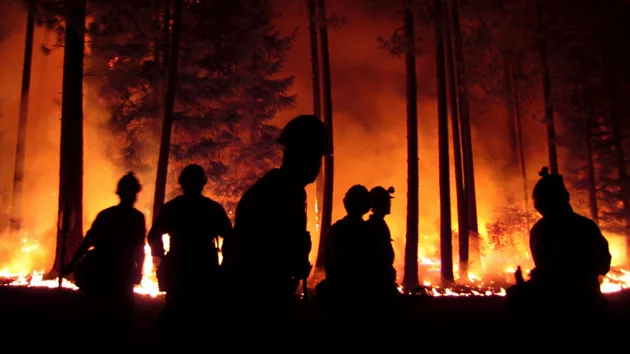
(NEW YORK) — More research is emerging to show how much more severe wildfires have become in recent decades.
The frequency and magnitude of extreme wildfires — the ones that cause the most damage to ecosystems, society and the climate — appear to have doubled over the past 20 years, according to a study published Monday in the journal Nature Ecology & Evolution.
Researchers at the University of Tasmania in Australia used satellite data from 2003 to 2023 to identify active hot spots and calculate the summed intensity of a fire event.
“Extreme wildfires are on the rise,” Calum Cunningham, a professor of pyrogeography at the University of Tasmania and author of the study, told ABC News via email. “Surprisingly, this finding hadn’t been shown until now, owing to the relatively short length of global satellite datasets.”
The team found the increase in extreme events was mostly driven by more intense fires in temperate coniferous forests — which are forests made up of trees that have needle-like leaves — and boreal forests, which are a subset of coniferous forests, including in North America and Russia. This is likely related to the increased aridity in these forests over recent years due to climate change, researchers said.
In boreal forests, where the increases were the largest, large amounts of carbon have been released by extreme fires, threatening to create a feedback effect that further magnifies warming, Cunningham said.
The Nearctic and Australasia/Oceania regions were most affected by extreme events, researchers said. In addition, the six most extreme years for these escalated wildfires have occurred since 2017, the study found.
The rise in extreme wildfires “certainly [carry] the fingerprints of climate change,” Cunningham said, adding that he was shocked by the magnitude of the increases.
“Many of these extreme events occurred in years with record heat and dryness, when fuels become extremely dry, allowing them to burn at very high intensities,” he said.
A warming climate will be even more conducive to extreme wildfire events, highlighting the need for emergency planners to adapt and prepare for more devastating infernos in the future. Exponential increases in extreme fire activity will undoubtedly increase should global temperatures continue to rise, Cunningham said.
“If the atmosphere continues to warm and dry, as expected, then it’s likely fire [behavior] in some ecosystems will continue to worsen,” Cunningham said.
The new study adds to the growing body of research with similar findings.
In the U.S., the frequency of extreme fire risk has grown 20 times over recent decades, according to a report published by Deep Sky, a Canadian carbon removal project developer, earlier this month.
Levels of widespread extreme fire risk that used to occur once every 100 years are now expected to occur every five years, the report found.
The regions found to be experiencing the most increases in extreme fire weather are central Colorado and northern New Mexico, according to the report. Central California is facing staggering increases in extreme fire weather.
Last year, Canada experienced a record-breaking fire season, and wildfires have already begun to sweep through the West.
The path forward must include significant action to slow and reverse climate change as well as local-scale land management to implement strategies to reduce fire intensity, Cunningham said, adding that better evacuation protocols and hardening of existing buildings to make them more resilient to fires will all be necessary in the future.
Copyright © 2024, ABC Audio. All rights reserved.








